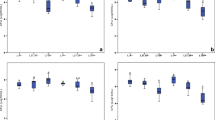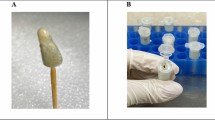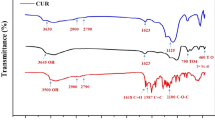Abstract
To our knowledge, there is still no evidence in relation to the combination of curcumin with chelants to improve the effects of antimicrobial photodynamic therapy (aPDT) on complex dental caries biofilms. Therefore, the aim of this study was to evaluate the antimicrobial effect of curcumin-ethylenediaminetetraacetic acid (EDTA)-mediated aPDT on the vitality of intact biofilms of dentin caries microcosms. Biofilms were grown on glass slabs in McBain medium plus 1% sucrose in microaerophily at 37 °C for 5 days. Then, biofilms were treated with associations of 600 μmol L−1 curcumin combined or not with 1% EDTA and 37.5 or 75 J cm−2 LED (455 nm). The vitality was determined by a confocal laser scanning microscopy (CLSM) after staining biofilms with a mixture of 2.5 g L−1 fluorescein diacetate and 0.25 g L−1 ethidium bromide. Statistical analysis was conducted by Kruskal-Wallis and post hoc Dunn’s test (P < 0.05). Three treatments were able to reduce the vitality of overall biofilms: curcumin + 75 J cm−2 LED, curcumin-EDTA + 37.5 J cm−2 LED, and curcumin-EDTA + 75 J cm−2 LED. Also, the vitality of inner layers of biofilms was significantly reduced only after the combination of aPDT with EDTA. Therefore, the association of curcumin and EDTA improved the antimicrobial effect of aPDT on dentin caries microcosms, considering the application of lower light densities and deeper layers of biofilms.



Similar content being viewed by others
References
Santezi C, Reina BD, Dovigo LN (2018) Curcumin-mediated photodynamic therapy for the treatment of oral infections-a review. Photodiagn Photodyn Ther 21:409–415
Araujo NC, Fontana CR, Bagnato VS, Gerbi ME (2012) Photodynamic effects of curcumin against cariogenic pathogens. Photomed Laser Surg 30(7):393–399
Araujo NC, Fontana CR, Bagnato VS, Gerbi ME (2014) Photodynamic antimicrobial therapy of curcumin in biofilms and carious dentine. Lasers Med Sci 29(2):629–635
Araujo NC, Fontana CR, Gerbi ME, Bagnato VS (2012) Overall-mouth disinfection by photodynamic therapy using curcumin. Photomed Laser Surg 30(2):96–101
Manoil D, Filieri A, Gameiro C, Lange N, Schrenzel J, Wataha JC, Bouillaguet S (2014) Flow cytometric assessment of Streptococcus mutans viability after exposure to blue light-activated curcumin. Photodiagn Photodyn Ther 11(3):372–379
Duvoix A, Blasius R, Delhalle S, Schnekenburger M, Morceau F, Henry E, Dicato M, Diederich M (2005) Chemopreventive and therapeutic effects of curcumin. Cancer Lett 223(2):181–190
Finley JW (2005) Proposed criteria for assessing the efficacy of cancer reduction by plant foods enriched in carotenoids, glucosinolates, polyphenols and selenocompounds. Ann Bot 95(7):1075–1096
Paschoal MA, Tonon CC, Spolidorio DM, Bagnato VS, Giusti JS, Santos-Pinto L (2013) Photodynamic potential of curcumin and blue LED against Streptococcus mutans in a planktonic culture. Photodiagn Photodyn Ther 10(3):313–319
Tonon CC, Paschoal MA, Correia M, Spolidorio D, Bagnato VS, Giusti J, Santos-Pinto L (2015) Comparative effects of photodynamic therapy mediated by curcumin on standard and clinical isolate of Streptococcus mutans. J Contemp Dent Pract 16(1):1–6
Nong HV, Hung LX, Thang PN, Chinh VD, Vu LV, Dung PT, Trung TV, Nga PT (2016) Fabrication and vibration characterization of curcumin extracted from turmeric (Curcuma longa) rhizomes of the northern Vietnam. Springerplus 5(1):1147
Konopka K, Goslinski T (2007) Photodynamic therapy in dentistry. J Dent Res 86(8):694–707
Maisch T (2007) Anti-microbial photodynamic therapy: useful in the future? Lasers Med Sci 22(2):83–91
Taraszkiewicz A, Fila G, Grinholc M, Nakonieczna J (2013) Innovative strategies to overcome biofilm resistance. Biomed Res Int 2013:150653
Vatansever F, de Melo WC, Avci P, Vecchio D, Sadasivam M, Gupta A, Chandran R, Karimi M, Parizotto NA, Yin R, Tegos GP, Hamblin MR (2013) Antimicrobial strategies centered around reactive oxygen species--bactericidal antibiotics, photodynamic therapy, and beyond. FEMS Microbiol Rev 37(6):955–989
Zaura-Arite E, van Marle J, ten Cate JM (2001) Conofocal microscopy study of undisturbed and chlorhexidine-treated dental biofilm. J Dent Res 80(5):1436–1440
de Kievit TR, Iglewski BH (2000) Bacterial quorum sensing in pathogenic relationships. Infect Immun 68(9):4839–4849
Antunes LC, Ferreira RB, Buckner MM, Finlay BB (2010) Quorum sensing in bacterial virulence. Microbiology 156(Pt 8):2271–2282
Costerton JW, Stewart PS, Greenberg EP (1999) Bacterial biofilms: a common cause of persistent infections. Science 284(5418):1318–1322
Costerton W, Veeh R, Shirtliff M, Pasmore M, Post C, Ehrlich G (2003) The application of biofilm science to the study and control of chronic bacterial infections. J Clin Invest 112(10):1466–1477
Haapasalo M, Shen Y, Wang Z, Gao Y (2014) Irrigation in endodontics. Br Dent J 216(6):299–303
Zehnder M (2006) Root canal irrigants. J Endod 32(5):389–398
George S, Hamblin MR, Kishen A (2009) Uptake pathways of anionic and cationic photosensitizers into bacteria. Photochem Photobiol Sci 8(6):788–795
Wood SR, Kirkham J, Marsh PD, Shore RC, Nattress B, Robinson C (2000) Architecture of intact natural human plaque biofilms studied by confocal laser scanning microscopy. J Dent Res 79(1):21–27
Dige I, Nyengaard JR, Kilian M, Nyvad B (2009) Application of stereological principles for quantification of bacteria in intact dental biofilms. Oral Microbiol Immunol 24(1):69–75
McBain AJ, Sissons C, Ledder RG, Sreenivasan PK, De Vizio W, Gilbert P (2005) Development and characterization of a simple perfused oral microcosm. J Appl Microbiol 98(3):624–634
Rudney JD, Chen R, Lenton P, Li J, Li Y, Jones RS, Reilly C, Fok AS, Aparicio C (2012) A reproducible oral microcosm biofilm model for testing dental materials. J Appl Microbiol 113(6):1540–1553
Filoche SK, Soma KJ, Sissons CH (2007) Caries-related plaque microcosm biofilms developed in microplates. Oral Microbiol Immunol 22(2):73–79
Li Y-H, Tang N, Aspiras MB, Lau PC, Lee JH, Ellen RP, Cvitkovitch DG (2002) A quorum-sensing signaling system essential for genetic competence in Streptococcus mutans is involved in biofilm formation. J Bacteriol 184(10):2699–2708
Signori C, van de Sande FH, Maske TT, de Oliveira EF, Cenci MS (2016) Influence of the inoculum source on the cariogenicity of in vitro microcosm biofilms. Caries Res 50(2):97–103
Soria-Lozano P, Gilaberte Y, Paz-Cristobal MP, Perez-Artiaga L, Lampaya-Perez V, Aporta J, Perez-Laguna V, Garcia-Luque I, Revillo MJ, Rezusta A (2015) In vitro effect photodynamic therapy with differents photosensitizers on cariogenic microorganisms. BMC Microbiol 15:187
Andrade MC, Ribeiro AP, Dovigo LN, Brunetti IL, Giampaolo ET, Bagnato VS, Pavarina AC (2013) Effect of different pre-irradiation times on curcumin-mediated photodynamic therapy against planktonic cultures and biofilms of Candida spp. Arch Oral Biol 58(2):200–210
Araujo NC, de Menezes RF, Carneiro VSM, Dos Santos-Neto AP, Fontana CR, Bagnato VS, Harvey CM, Gerbi MEM (2017) Photodynamic inactivation of cariogenic pathogens using curcumin as photosensitizer. Photomed Laser Surg 35(5):259–263
Quishida CC, Mima EG, Dovigo LN, Jorge JH, Bagnato VS, Pavarina AC (2015) Photodynamic inactivation of a multispecies biofilm using photodithazine((R)) and LED light after one and three successive applications. Lasers Med Sci 30(9):2303–2312
Silva TC, Pereira AF, Buzalaf MA, Machado MA, Crielaard W, Deng DM (2014) Diverse outcomes of photodynamic antimicrobial chemotherapy on five enterococcus faecalis strains. Photodiagn Photodyn Ther 11(3):283–289
Arias-Moliz MT, Ferrer-Luque CM, Espigares-Garcia M, Baca P (2009) Enterococcus faecalis biofilms eradication by root canal irrigants. J Endod 35(5):711–714
Ordinola-Zapata R, Bramante CM, Cavenago B, Graeff MS, Gomes de Moraes I, Marciano M, Duarte MA (2012) Antimicrobial effect of endodontic solutions used as final irrigants on a dentine biofilm model. Int Endod J 45(2):162–168
Helander IM, Mattila-Sandholm T (2000) Permeability barrier of the gram-negative bacterial outer membrane with special reference to nisin. Int J Food Microbiol 60(2–3):153–161
Vaara M (1992) Agents that increase the permeability of the outer membrane. Microbiol Rev 56(3):395–411
Hu J, Lin S, Tan BK, Hamzah SS, Lin Y, Kong Z, Zhang Y, Zheng B, Zeng S (2018) Photodynamic inactivation of Burkholderia cepacia by curcumin in combination with EDTA. Food Res Int 111:265–271
Soukos NS, Mulholland SE, Socransky SS, Doukas AG (2003) Photodestruction of human dental plaque bacteria: enhancement of the photodynamic effect by photomechanical waves in an oral biofilm model. Lasers Surg Med 33(3):161–168
Mendez DAC, Gutierrez E, Dionisio EJ, Oliveira TM, Buzalaf MAR, Rios D, Machado M, Cruvinel T (2018) Effect of methylene blue-mediated antimicrobial photodynamic therapy on dentin caries microcosms. Lasers Med Sci 33(3):479–487
de Oliveira FS, Cruvinel T, Cusicanqui Mendez DA, Dionisio EJ, Rios D, Machado M (2018) The in vitro effect of antimicrobial photodynamic therapy on dental microcosm biofilms from partially erupted permanent molars: a pilot study. Photodiagn Photodyn Ther 21:163–167
Méndez DAC, Gutierres E, Dionísio EJ, Buzalaf MAR, Oliveira RC, Machado MAAM, Cruvinel T (2018) Curcumin-mediated antimicrobial photodynamic therapy reduces the viability and vitality of infected dentin caries microcosms. Photodiagn Photodyn Ther 24:102–108. https://doi.org/10.1016/j.pdpdt.2018.09.007
Matsumoto-Nakano M (2018) Role of Streptococcus mutans surface proteins for biofilm formation. Jpn Dent Sci Rev 54(1):22–29
Dige I, Nilsson H, Kilian M, Nyvad B (2007) In situ identification of streptococci and other bacteria in initial dental biofilm by confocal laser scanning microscopy and fluorescence in situ hybridization. Eur J Oral Sci 115(6):459–467
Silva TC, Pereira AF, Exterkate RA, Bagnato VS, Buzalaf MA, Machado MA, Ten Cate JM, Crielaard W, Deng DM (2012) Application of an active attachment model as a high-throughput demineralization biofilm model. J Dent 40(1):41–47
Deng DM, Hoogenkamp MA, Exterkate RA, Jiang LM, van der Sluis LW, Ten Cate JM, Crielaard W (2009) Influence of Streptococcus mutans on enterococcus faecalis biofilm formation. J Endod 35(9):1249–1252
Exterkate RA, Crielaard W, Ten Cate JM (2010) Different response to amine fluoride by Streptococcus mutans and polymicrobial biofilms in a novel high-throughput active attachment model. Caries Res 44(4):372–379
Wang D, Shen Y, Ma J, Hancock RE, Haapasalo M (2017) Antibiofilm effect of D-enantiomeric peptide alone and combined with EDTA in vitro. J Endod 43(11):1862–1867
Acknowledgements
The authors thank Dr. Vanderlei Bagnato for his collaboration in the infrastructure of this research.
Role of funding source
This study was financed by São Paulo Research Foundation, with a research support (#2014/10890-0) and a master’s scholarship (#2014/22238-1).
Author information
Authors and Affiliations
Corresponding author
Ethics declarations
Ethical approval
This research protocol was approved by the Committee for Ethics in Human Research of the Bauru School of Dentistry (CAAE: 34559314.6.0000.5417), following ethical standards of the Declaration of Helsinki.
Conflict of interest
The authors declare that they have no conflict of interest.
Rights and permissions
About this article
Cite this article
Méndez, D.A.C., Rizzato, V.L., Lamarque, G.C.C. et al. Could a chelant improve the effect of curcumin-mediated photodynamic antimicrobial chemotherapy against dental intact biofilms?. Lasers Med Sci 34, 1185–1192 (2019). https://doi.org/10.1007/s10103-018-02708-x
Received:
Accepted:
Published:
Issue Date:
DOI: https://doi.org/10.1007/s10103-018-02708-x




